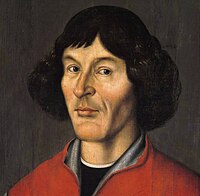Nicolaus Copernicus was born on February 19, 1473 in Torun, Poland. Circa 1508, Copernicus developed his own celestial model of a heliocentric planetary system. Around 1514, he shared his findings in the Commentariolus. His second book on the topic, De revolutionibus orbium coelestium, was banned by the Roman Catholic Church decades after his May 24, 1543 death in Frauenburg, Poland.
Famed astronomer Nicolaus Copernicus (Mikolaj Kopernik, in German) came into the world on February 19, 1473. The fourth and youngest child born to Nicolaus Copernicus Sr. and Barbara Watzenrode, an affluent copper merchant family in Torun, Poland, Copernicus was technically born of German heritage—by the time he was born, Torun had ceded to Poland, rendering him a citizen under the Polish crown. German was Copernicus's first language, but some scholars believe that he spoke some Polish as well.
When Copernicus was 10 years old, his father passed away. His maternal uncle, Bishop of Varmia Lucas Watzenrode, generously assumed the paternal role, taking it upon himself to ensure that Copernicus received the best possible education.
In 1491, Copernicus entered the University of Cracow, where he studied painting and mathematics. Though he did not take astronomy classes at that time, he developed a growing interest in the cosmos, and started collecting books on the topic.
Upon graduating from Cracow in 1494, Copernicus returned to Torun, where he took a canon's position—arranged by his uncle—at Frombork's cathedral. Though the opportunity was only typically available to priests, Copernicus was able to hold onto the job for the rest of his life. It was a fortunate stroke for Copernicus: The canon's position afforded him the opportunity to fund the continuation of his studies for as long as he liked. Still, the job demanded much of his schedule; he was only able to pursue his academic interests intermittently, during his free time.
In 1496, Copernicus took leave and traveled to Italy, where he enrolled in a religious law program at the University of Bologna. There, he met astronomer Domenico Maria Novara—a fateful encounter, as the two began exchanging astronomical ideas and observations. Historian Edward Rosen described the relationship as follows: "In establishing close contact with Novara, Copernicus met, perhaps for the first time in his life, a mind that dared to challenge the authority of [astrologist Claudius Ptolemy] the most eminent ancient writer in his chosen fields of study." The friends were so enthralled in their intellectual exchange, they decided to become roommates.
In 1500, after completing his law studies in Bologna, Copernicus went on to study practical medicine at the University of Padua. He did not, however, stay long enough to earn a degree, since the two-year leave of absence from his canon position was nearing expiration. In 1503, Copernicus attended the University of Ferrara, where he prepared to take the canon law exam. After passing the test on his first attempt, he hurried back home to Poland, where he resumed his position as canon and rejoined his uncle at a nearby Episcopal residence. Copernicus remained at the Lidzbark-Warminski residence for the next seven years, working and tending to his elderly, ailing uncle, and exploring astronomy whenever he could find the time.
In 1510, Copernicus moved to a residence in the Frombork Cathedral Chapter in hopes of clearing additional time to study astronomy. He would live there as a canon for the duration of his life.
